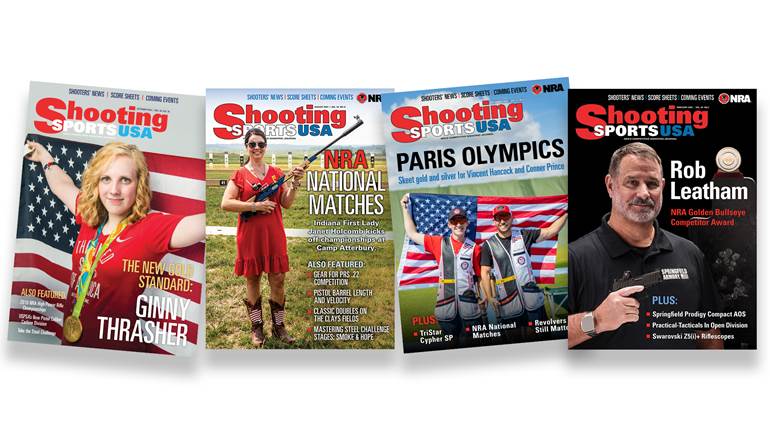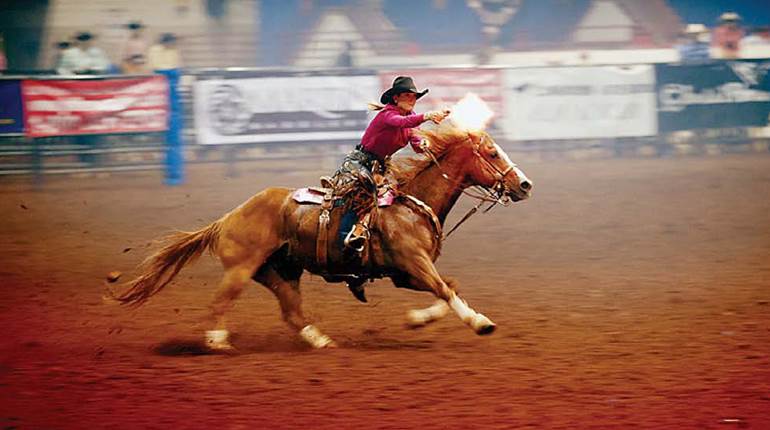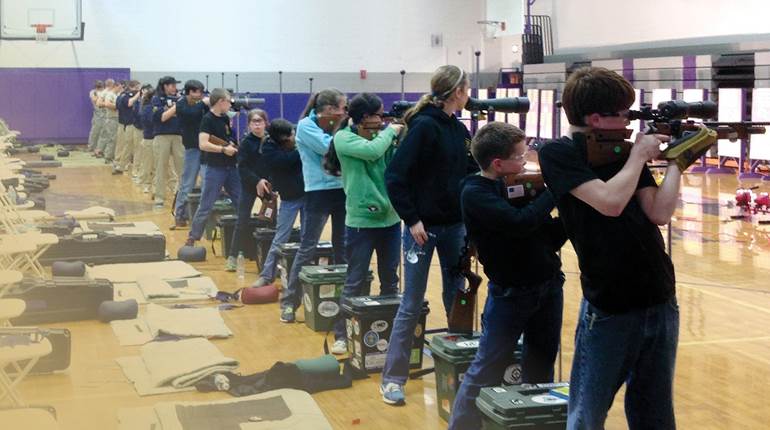
From the July, 1945 issue of American Rifleman
Law enforcement officers without guns in this modern day would seem paradoxical, yet not so many years ago Special Agents of the FBI were without statutory authority to carry weapons.
Then came the “Bloody Thirties,” when gangsterism reached its apex. The early years of this era saw gangs of hoodlums spreading terror with flaming guns across the length and breadth of the United States. They committed murders, kidnappings, bank robberies, and gang killings. They robbed and pillaged with no respect for law and no regard for human life. Vultures in human form, they were courageous only when they stood behind a machine gun, shotgun, revolver, or pistol. The only law those gangsters understood was a law backed by guns and straight shooting. The country needed men clothed with the power of arrest and men who could shoot it out, if necessary, with those hoodlums. Citizens became incensed and demanded action.
The American People looked to Congress to act as it was apparent that local and state governments could not compete with the gangsters who, after committing a crime, fled from state to state or in many instances from one end of the country to the other by train, plane, and automobile. Congress took the needed action by passing new laws and putting teeth in old laws in the spring of 1934.
The months of May and June, 1934, are red-letter months in the history of law enforcement in the United States. On May 18, 1934, Congress passed an act providing punishment for the killing or assaulting of Federal officers, and that same date a revised kidnapping statute was approved. Soon other laws relative to assault, bank robbery, and interstate flight to avoid prosecution came into being. On May 22, 1934, the National Stolen Property Act was enacted and on June 18, 1934, Congress empowered Special Agents of the Federal Bureau of Investigation to carry firearms and make arrests.
This series of laws spelled doom for the flourishing gangsters. The Federal Bureau of Investigation immediately inaugurated a special firearms training program for its agents. The best available weapons were selected and the finest firearms experts in the country began teaching the Special Agents during those early years proved their worth and turned gangsterism into a dangerous and extremely unremunerative “calling.”
The FBI adopted as its official handgun a .38 caliber revolver which is issued to every Special Agent of the FBI on his first day in training school. A great portion of the work of Special Agents involves cases in which firearms are unnecessary, yet it is important to have a gun which can be carried inconspicuously of light weight, and yet with plenty of power. In most of the cases in which firearms are needed by agents they are used at close range, usually ten to twenty-five yards, and for that reason it is not necessary to carry guns with a long range.
There are cases, however, in which rifles, machine guns, and shotguns must be used and, therefore, all agents are trained and must qualify with an average of 85 per cent or better with the repeating shotgun, a .30 caliber rifle, a .45 caliber machine gun, and the .357 Magnum revolver in addition to the .38 caliber revolver.
Each field office keeps a number of .357 caliber Magnum revolvers. The estimated effective range of this gun is 200 yards, while its maximum range is 2,700 yards. Because of its terrific power, it is used only in emergency cases when maximum penetration or shooting force is required. The powerful penetration or shooting force is required. The powerful penetrative effect of this gun can be more fully understood when it is realized that a bullet fired from it will pierce an automobile’s structure.
An excellent example of the use of the .357 caliber Magnum revolver occurred in a case handled by the FBI in Mississippi several years ago. At that time two FBI agents were in pursuit of two bank robbers who were shooting at the agents. The agents had fired their service revolvers at the back of the fleeing automobile with no effect. These two agents had been practicing with .357 caliber Magnum revolvers that morning and, therefore, had them in the glove compartment of the car at the moment. As soon as it was realized that the service revolvers were having no effect on the feeling car, the Magnum was used and one shot from this gun penetrated the trunk , the back seat, the front seat, the driver was killed instantly and the automobile wrecked.
With respect to rifles, the FBI first used the .30-’06 rifle because it had been proved satisfactory by the military forces for long range shooting and because cartridges were readily available. Experience over the years, however taught the FBI that this gun was too powerful for the work at hand and, therefore, a .30 caliber rifle with an estimated effective range of 300 yards was adopted. A rifle of this kind can be used with much effect in the western states and mountainous country where, in trailing a fugitive, it might be necessary to shoot at 200 or 300 yards. The rifle in use at the present time by the FBI is a .30 caliber autoloading rifle which is light in weight easy to carry, accurate, and a powerful weapon, having a muzzle velocity of 2,250 feet per second.
Another gun used by the FBI is the 12 gauge, cylinder-bore, repeating shotgun. This gun was very effectively used by an agent in recent years when standing at the bottom steps in the house of a fugitive. The fugitive suddenly darted down the steps and snapped a .45 caliber Colt in the agent’s face. In his desperate hurry, however, the fugitive had thrown the cartridge out of the barrel in his attempt to cock the weapon and, therefore, the agent’s life was saved. The agent immediately fired the shotgun and at that close range the fugitive was killed instantly.
The Thompson submachine gun is an additional powerful weapon used by Special Agents. This gun has an effective range of 100 yards, and on full-automatic fire will shoot at the rate of 600 shots per minute. The FBI has adopted the box-type clip for use of with this gun, as the clips are easy to carry and have thus far served all purposes necessary in Bureau work.
From the July, 1945 issue of American Rifleman
To make each man in the FBI service superior to any opponent in speed and accuracy, an exacting program is followed. For this purpose, outstanding experts in the field of firearms are on our staff. These men have for many years made a study of the art of shooting under every conceivable circumstance. Under these instructors, officials and Special Agents learn quick, straight, and accurate shooting. The training is based on the knowledge that an agent’s life, as well as the lives of his fellow agents, might some day depend entirely on his ability and skill in handling a revolver, a rifle, a machine gun, or a shotgun. Hours are spent learning the mechanical operation of these guns in order that the individual parts of each gun, and their particular functions are thoroughly mastered. The more knowledge an officer has concerning the gun he carries with him, the greater respect he has for that gun and its danger. Such respect lessens the possibility of accidents to himself and to others.
Before an agent is permitted to shoot on the range, he is given a course in sight alignment and dry firing. Sight alignment is, of course, essential to good shooting. Through dry firing, the agent becomes familiar with the firearm he is to use, and learns the “feel” of the gun properly seated in his hand or against his shoulder. In addition, he learns the all-important factor of “trigger squeeze.” By the time he is ready to go up to the firing line, he knows his weapon and how to shoot it.
The actual training consists of firing designated courses with each type of gun. The practical pistol course consists of fifty shots, and is designed to cover as many situations as possible under which the agent may have to shoot. For this course, a Colt silhouette target and the Colt .38 Official Police Revolver are used. The first ten shots are fired from hip level at a distance of seven yards from the target. Upon command, the gun is loaded with five cartridges and is holstered immediately. When the men on the firing line have all loaded and holstered their guns, the second command is given at which time the guns are drawn and fired from hip level without aiming. As soon as the first five shots have been discharged, the empty cartridges are taken out and five live cartridges are inserted and fired into the target. The over-all time for the firing of these ten shots, including unloading and reloading, is twenty-five seconds. The remainder of the course takes five and three-quarters minutes.
At the sixty-yard line, the Special Agent shoots five shots from a prone position. The shooter then moves to the fifty-yard line and shoots five shots sitting, five shots prone, five shots from behind a barricade with his left hand and five with his right hand. Moving rapidly to the twenty-five-yard line, he shoots five shots sitting, five with his right hand, and five with his left hand from behind a barricade. The total K-values given on the target are added and multiplied by .4 to arrive at the score.
The shotgun course is ten shots fired on command with buckshot at a bobber target. Standing at fifteen yards from the target, the Special Agent shoots five shots from the hip at five targets standing four feet apart. Then five shots are fired from the shoulder at five numbered targets standing ten, fifteen, twenty, thirty, and forty yards from the shooter who is given two seconds to fire at each target, after its number is called. Each “hit” counts ten. The scope equals the percentage earned.
The .45 caliber Thompson submachine-gun course consists of forty shots fired at bobber targets. At a point fifteen yards from the target, five shots are fired single-fire, and five shots in short bursts, on command, from the hip. At a point twenty-five yards from the target, using two clips containing ten cartridges each, the Special Agent fires ten shots single fire and ten shots in short bursts from the shoulder. These shots must be fired in twenty-five seconds which includes the time necessary for removing the first clip and inserting the second. At fifty yards, ten shots are fired from the shoulder single fire. Each hit has a value of two and one-half points.
The .30 caliber rifle course is composed of twenty shots on silhouette targets. Five shots are fired from a prone position and five from a sitting position at 200 yards. At 100 yards, five shots are fired from a standing position and five are fired from a kneeling position. The 200-yard course is a Slow-Fire course whereas the 100-yard course is a Timed-Fire course. At 100 yards, the shooter starts with a loaded weapon and must finish all ten shots in one minute including reloading. The total score of the twenty shots equals the percentage earned. In addition to the courses which have been described, a course in hip shooting is given, patterned after the first ten shots of the practical pistol course. The entire course is fired on command, starting with twelve shots fired singly, twelve shots fired two in succession, six shots in groups of three, six shots singly, four shots in groups of two, and then ten shots in groups of five under the same conditions as described at the start of the practical pistol course, making a total of fifty shots. The course is fired on a silhouette target and each shot in the black has a value of two.
The care of firearms used by FBI personnel is rigidly stressed so that weapons will be available immediately when needed. Each time a gun is shot, it is thoroughly cleaned and oiled. Before placing the firearm in the gun vaults, the tension on firing mechanism, hammer, and recoil springs is released. No dust, rust or corrosion is permitted in the barrel or on the outside of any weapon. These rules are strictly followed whether an agent uses a personally owned firearm or one issued to him.
During all firearms training, absolute adherence to all safety rules is required. The basic principle of range safety rules is that an agent must determine whether or not a weapon is loaded when it is picked up or laid down. No weapon is ever loaded on the range unless it is on the firing line with the muzzle pointed down range toward the targets, or at a forty-five degree elevation. Revolvers must remain in their holsters unless the shooter is on the firing line, and then may be drawn or loaded only upon the command of the range officer. Talking is not permitted between agents standing at the firing line unless the person speaking is the range officer or is coaching the shooter. If it becomes necessary for an agent to proceed from the firing point to the targets, he can do so only upon the command of the range officer who first instructs all shooters to unload and lay down or holster their weapons. Care is also taken to remove any objects immediately behind the target area which may cause a bullet to ricochet. Carelessness or thoughtlessness of any kind is not tolerated on the firearms range.
Not only is each agent thoroughly schooled in every phase of firearms training, but he is also required to maintain marksmanship qualifications through regular monthly practice. Special Agents are prepared and ready at all times to protect society from criminals who defy the laws of order and decency. Through intensive, thorough knowledge and training, a Special Agent is master of the situation when he stands face to face with a criminal. His training is a part of him and his reflexes become automatic as he goes into action. There is a sure, cool steadiness about his motion when the time comes for him to put into practices the training he has received.
















![Winchester Comm[94]](/media/1mleusmd/winchester-comm-94.jpg?anchor=center&mode=crop&width=770&height=430&rnd=134090756537800000&quality=60)
![Winchester Comm[94]](/media/1mleusmd/winchester-comm-94.jpg?anchor=center&mode=crop&width=150&height=150&rnd=134090756537800000&quality=60)


















